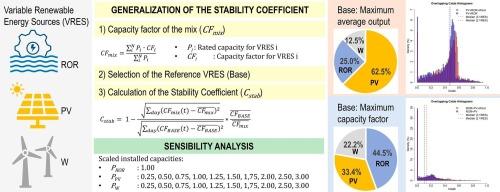利用稳定系数评价山区集水区微尺度光风水电互补性
IF 7
2区 工程技术
Q1 ENERGY & FUELS
Sustainable Energy Technologies and Assessments
Pub Date : 2025-09-04
DOI:10.1016/j.seta.2025.104537
引用次数: 0
摘要
由于可变可再生能源的不可调度性,将其整合到能源系统中具有挑战性。最近,互补的可再生能源发电被认为有望提供更平滑的VRES集成,通常是耦合两个VRES;然而,研究表明,在某些情况下,耦合三个或更多的VRES可能更有效。缺乏标准化的方法来量化三个或更多VRES之间的互补性,这阻碍了对混合系统稳定性的准确评估,特别是在分散和小规模的环境中,最佳组合对可靠性至关重要。本研究评估了参考VRES的选择如何影响稳定系数(Cstab)指标的值和解释,其最初目标是表示与参考VRES相比混合电力系统容量因子(CFmix)可变性的减少。该研究还比较了扩展后的Cstab与总时间互补性指数,讨论了异同。案例研究使用来自波兰Kłodzko的多年小时流量、风和太阳数据系列。结果表明,扩展的Cstab度量有效地表示了三个VRES之间的互补性。在案例研究中,采用3个VRES的方案显示出更高的装机容量和Cstab值,分别增加了12.5%至45.2%和2.6%至40.6%。然而,这些案例也显示出较低的CFmix值,与具有两个VRES的系统相比,降低了3.2%至74.8%。本文章由计算机程序翻译,如有差异,请以英文原文为准。

Assessing micro-scale solar-wind-hydro complementarity in a mountainous catchment through the stability coefficient
Integrating variable renewable energy sources (VRES) into energy systems is challenging due to their non-dispatchability. Recently, complementary renewable generation has been deemed promising for providing smoother VRES integration, typically coupling two VRES; nevertheless, research has shown that coupling three or more VRES could be more effective in some instances. The lack of standardized methods to quantify complementarity among three or more VRES hinders the accurate assessment of hybrid systems’ stability, especially in decentralized and small-scale contexts where optimal combinations are essential for reliability. This study evaluates how the choice of the reference VRES affects the value and interpretation of the stability coefficient (Cstab) metric, whose original goal is to represent the reduction in the capacity factor (CFmix) variability of a hybrid power system compared to a reference VRES. The study also compares the extended Cstab with the total temporal complementarity index, discussing similarities and differences. The case study uses multiannual hourly flow, wind, and solar data series from Kłodzko, Poland. The results indicate that the extended Cstab metric effectively represents the complementarity among three VRES. For the case study, the scenarios incorporating 3 VRES showed a higher installed capacity and Cstab values, with increases ranging from 12.5 % to 45.2 % and from 2.6 % to 40.6 %, respectively. However, these cases also show lower CFmix values, decreasing between 3.2 % and 74.8 % compared to systems with two VRES.
求助全文
通过发布文献求助,成功后即可免费获取论文全文。
去求助
来源期刊

Sustainable Energy Technologies and Assessments
Energy-Renewable Energy, Sustainability and the Environment
CiteScore
12.70
自引率
12.50%
发文量
1091
期刊介绍:
Encouraging a transition to a sustainable energy future is imperative for our world. Technologies that enable this shift in various sectors like transportation, heating, and power systems are of utmost importance. Sustainable Energy Technologies and Assessments welcomes papers focusing on a range of aspects and levels of technological advancements in energy generation and utilization. The aim is to reduce the negative environmental impact associated with energy production and consumption, spanning from laboratory experiments to real-world applications in the commercial sector.
 求助内容:
求助内容: 应助结果提醒方式:
应助结果提醒方式:


